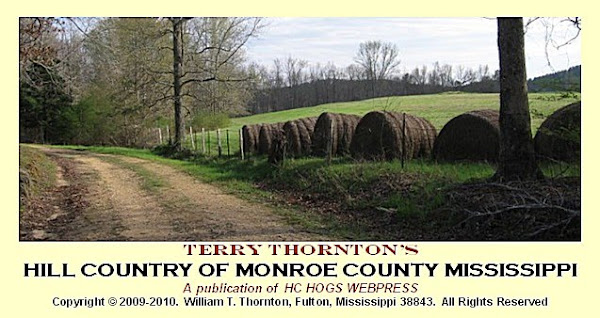Monroe County Founding Fathers Ride Horses to Texas and Back
by Terry Thornton
On January 9, 1835, a group of six Mississippi Hill Country men climbed on their horses and left the warmth of their homes to begin an exploration of Mexican Texas.
A light snow covered the ground on that day 175 years ago.
The group led two pack horses laden with supplies and were followed by a camp dog. The older men were two of the earliest settlers of Monroe County. One was Frederick Weaver, a sixty-year-old Methodist minister. Weaver had led the first wagon-train of settlers to Monroe County in 1816 and had settled along the creek which today bears his name. Gideon Lincecum, age 42, was the leader of the group. Lincecum came to Monroe County in 1818 and was a successful businessman and physician.
When Mississippi approved the formation of a new county in 1821, Lincecum was appointed Chief Justice and Weaver became one of the Associate Justices who formally established Monroe County.
During 1834-35, the "go-to-Texas" fever raged across the southland. In Monroe County a scouting party was organized to go to Mexican Texas to find property. Lincecum's first trip to Texas failed in 1834 when no one showed up to leave with him --- and he announced another attempt for early January 1835.
Joining Lincecum were G. Lincecum, his brother, and four others: Frederick Weaver was my great-great-great-grandfather who may have been living at this time between present-day Parham and Hatley. His son Calvin, age 33, went with him to Texas. Benjamin Nix, son of John Nix, another of my great-great-great-grandfathers, owned property straddling Weaver's Creek just west of Becker. John Gwin, the youngest man on the trip, is somewhat of a mystery. He may be the son of Matthew Gwin who died about 1823 leaving John and other siblings with their mother, Mary Gwin.
At the time Gideon Lincecum left on this trip, he was living about ten miles from Cotton Gin Port, probably at Wall's Tanyard. His house and clinic might have been on present-day Hatley-Detroit Road just east of Hatley.
The group had $1,010 to pay their expenses --- but primarily they planned to live-off-the-land. They carried "meal, a little bacon, a six-gallon brass kettle, coffee pot, tin pans, and a pint tin cup a piece . . . a good double tent . . . rifles . . . coffee, sugar, and soap." They also had salt, a small steel mill for grinding corn, and red pepper.
The men, horses and dog traveled down the Natchez Trace to Port Gibson and crossed the Mississippi River on January 23. By February 3 they had ridden across Louisiana and crossed the Sabine River into Mexican Texas.
In March 8, 1835 when the Mississippi group arrived in Bastrop, Texas, Weaver is reported to have said, "Well, Gid, we have come to the conclusion that we have seen enough of Texas" and the group disbanded. Lincecum continued to explore alone. He did not return to Monroe County until August. Most of the others returned immediately to Mississippi arriving home by the end of April to mid-May.
Lincecum found property he liked but it was 1848, before he actually moved to Texas. By then the region had won independence from Mexico, had formed a separate nation, the Republic of Texas, and then had become a State of the United States of America.
Calvin Weaver stayed in Texas when the group splint up. He fought for Texas Independence and was present at the Battle of San Jacinto in 1836.
Frederick Weaver returned to Monroe County where in 1850, he married for the third time, Sarah Marrs Stockton, widow of William Stockton. They moved to Texas in 1852, he died in 1853 and was buried in Bastrop County. His widow returned to Monroe County and is buried in New Hope Cemetery at Parham.
Lincecum died and was buried in Texas in 1874. His remains were removed to the State Cemetery, Austin, and placed in a grave in Row One of the Austin plot, the grave of the Father of Texas.
Lincecum and Weaver are both linked with the settlement and development of Monroe County. Both had the "go-to-Texas" dream. Weaver lived in Monroe County for about 36 years; Lincecum lived here about 30 years. Both their names are forever linked to the history of Monroe County.
Read the complete journal of this trip in Burkhalter's Gideon Lincecum 1793 - 1874: A Biography (U Texas Press, Austin, 1965).
~~~~~~~~~~
Terry Thornton is a retired college administrator and former Amory Middle School principal who resides in Fulton. He can be contacted at hillcountrymonroecounty@gmail.com.
~~~~~~~~~~

1 comment:
Very interesting and informative article. Thanks for the great research.
Post a Comment